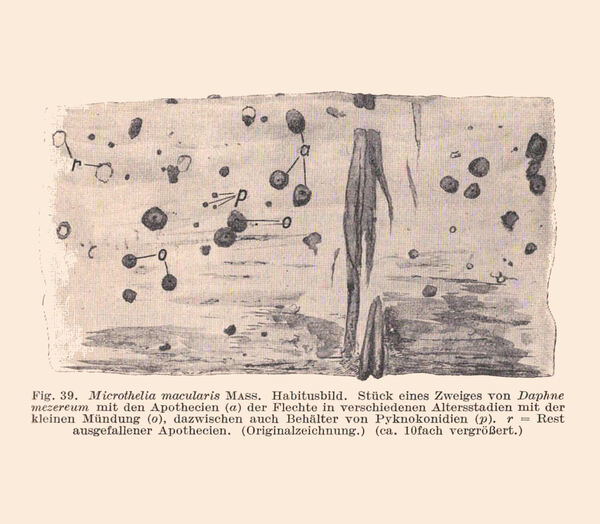Mycomicrothelia macularis (Hampe ex A. Massal.) Keissl.
Rabenh. Krypt.-Flora, 9, 1, 2: 36, 1936. Basionym: Microthelia macularis Hampe ex A. Massal. - Miscell. Lichenol.: 58, 1856.
Synonyms: Didymosphaeria analeptoides (Bagl. & Carestia) Rehm; Melanospora macularis (Hampe ex A. Massal.) Körb.; Microthelia analeptoides Bagl. & Carestia; Tomasellia macularis (Hampe ex A. Massal.) Blomb. & Forssell; Verrucaria analeptoides (Bagl. & Carestia) Hue
Distribution: N - Piem (Isocrono & al. 2004).
Description: Thallus crustose, fully endosubstratic and very poorly evident. Perithecia black, circular to elliptical in surface view, 0.1-0.2 mm across, abundant, sometimes crowded and then occasionally confluent, projecting only with the ostiole, with a dark brown, mainly 9-12 µm thick involucrellum reacting K+ olive-green, extending laterally and forming a distinct, up to 50 µm wide, dark brown to black fringe around the perithecium, formed of incorporated bark cells and radially oriented, 2-3 µm thick, rather uneven, irregularly branched, smooth-walled cells. Exciple often poorly developed to absent in lower part, 2-8 µm thick, composed of 1-5, 2-3 µm wide layers of interwoven hyphae, compacted, more or less brown. Hamathecium of branched and anastomosing, persistent, filiform, rather sparse, 2-3 µm thick pseudoparaphyses; hymenial gel I-. Asci 8-spored, elongate-clavate, with two functional wall layers, fissitunicate, with an internal apical beak, K/I-. Ascospores, 1-septate and constricted at septum, brown, ellipsoid, the upper cell slightly longer and broader, the ends rounded, 11-18 x 4-7 µm, the wall warted, with a c. 2 µm thick gelatinous sheath swelling in K. Pycnidia black, immersed, 30-50 µm across, with only the deeply pigmented ostiole visible, the walls pseudoparenchymatous with pale brown cells; conidiogenous cells simple, hyaline, elongate-ampulliform, phialidic, 5-8 x 2-3 µm. Conidia bacilliform, hyaline, 5-8 x 0.7-1.5(-2) µm. Photobiont: usually absent or thallus hyphae loosely associated with Trentepohlia. Spot tests: K-, C-, KC-, P-, UV-. Chemistry: without lichen substances.Note: a non-lichenized species growing on twigs of shrubs, mostly of Daphne and Ribes; probably more widespread in the Alps.
Growth form: Fungus
Substrata: bark
Reproductive strategy: mainly sexual
Pioneer species
Commonnes-rarity: (info)
Alpine belt: absent
Subalpine belt: absent
Oromediterranean belt: absent
Montane belt: very rare
Submediterranean belt: absent
Padanian area: absent
Humid submediterranean belt: absent
Humid mediterranean belt: absent
Dry mediterranean belt: absent
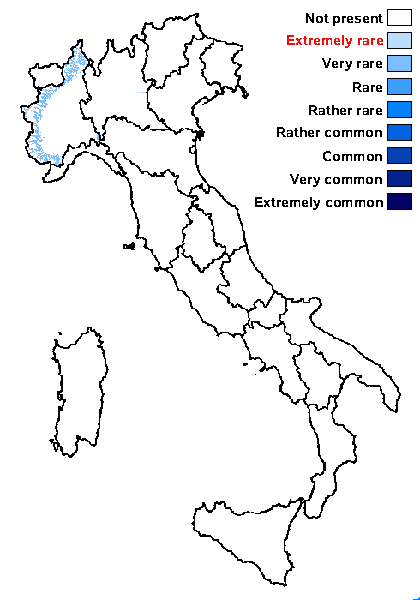
Predictive model
Herbarium samples
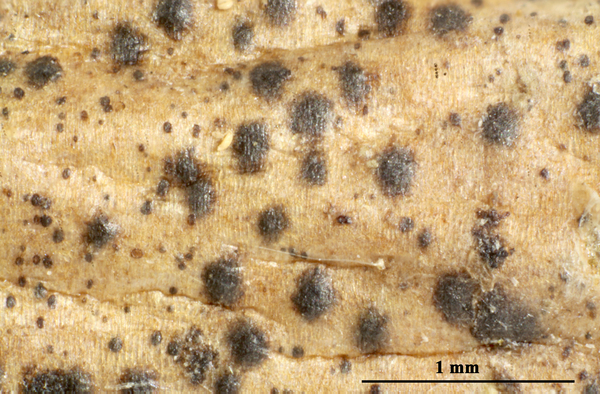

Felix Schumm - CC BY-SA 4.0
[Laurila7077], Finland, Prov. Kuusamo, Par. Salla, ad flumen Kutsajok in ripa accidentali locus Nivajanvi (ad insulam), ad corticem Daphnis mezerei in graminosa riparia. Leg. M. Laurila (no 7077, plantae fennicae), 25.07.1937, det. A. Aptroot
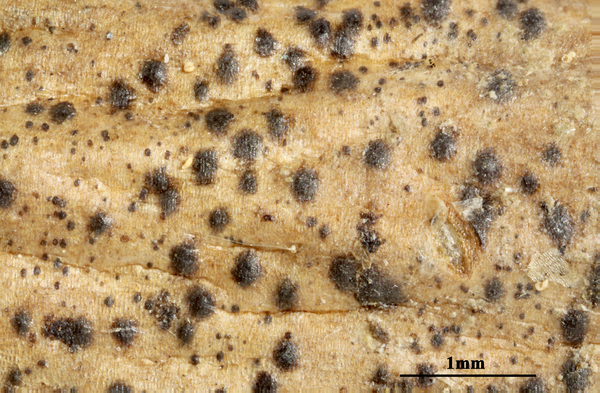

Felix Schumm - CC BY-SA 4.0
[Laurila7077], Finland, Prov. Kuusamo, Par. Salla, ad flumen Kutsajok in ripa accidentali locus Nivajanvi (ad insulam), ad corticem Daphnis mezerei in graminosa riparia. Leg. M. Laurila (no 7077, plantae fennicae), 25.07.1937, det. A. Aptroot
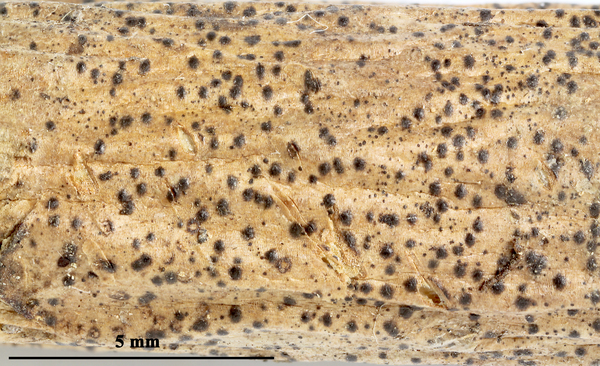

Felix Schumm - CC BY-SA 4.0
[Laurila7077], Finland, Prov. Kuusamo, Par. Salla, ad flumen Kutsajok in ripa accidentali locus Nivajanvi (ad insulam), ad corticem Daphnis mezerei in graminosa riparia. Leg. M. Laurila (no 7077, plantae fennicae), 25.07.1937, det. A. Aptroot
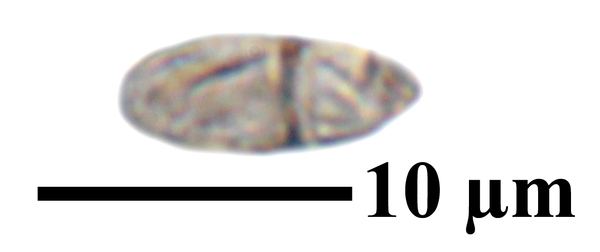

Felix Schumm - CC BY-SA 4.0
[Laurila7077], Finland, Prov. Kuusamo, Par. Salla, ad flumen Kutsajok in ripa accidentali locus Nivajanvi (ad insulam), ad corticem Daphnis mezerei in graminosa riparia. Leg. M. Laurila (no 7077, plantae fennicae), 25.07.1937, det. A. Aptroot
Growth form: Fungus
Substrata: bark
Reproductive strategy: mainly sexual
Pioneer species
Commonnes-rarity: (info)
Alpine belt: absent
Subalpine belt: absent
Oromediterranean belt: absent
Montane belt: very rare
Submediterranean belt: absent
Padanian area: absent
Humid submediterranean belt: absent
Humid mediterranean belt: absent
Dry mediterranean belt: absent

Predictive model
| Herbarium samples |


Felix Schumm - CC BY-SA 4.0
[Laurila7077], Finland, Prov. Kuusamo, Par. Salla, ad flumen Kutsajok in ripa accidentali locus Nivajanvi (ad insulam), ad corticem Daphnis mezerei in graminosa riparia. Leg. M. Laurila (no 7077, plantae fennicae), 25.07.1937, det. A. Aptroot


Felix Schumm - CC BY-SA 4.0
[Laurila7077], Finland, Prov. Kuusamo, Par. Salla, ad flumen Kutsajok in ripa accidentali locus Nivajanvi (ad insulam), ad corticem Daphnis mezerei in graminosa riparia. Leg. M. Laurila (no 7077, plantae fennicae), 25.07.1937, det. A. Aptroot


Felix Schumm - CC BY-SA 4.0
[Laurila7077], Finland, Prov. Kuusamo, Par. Salla, ad flumen Kutsajok in ripa accidentali locus Nivajanvi (ad insulam), ad corticem Daphnis mezerei in graminosa riparia. Leg. M. Laurila (no 7077, plantae fennicae), 25.07.1937, det. A. Aptroot


 INDEX FUNGORUM
INDEX FUNGORUM
 GBIF
GBIF

